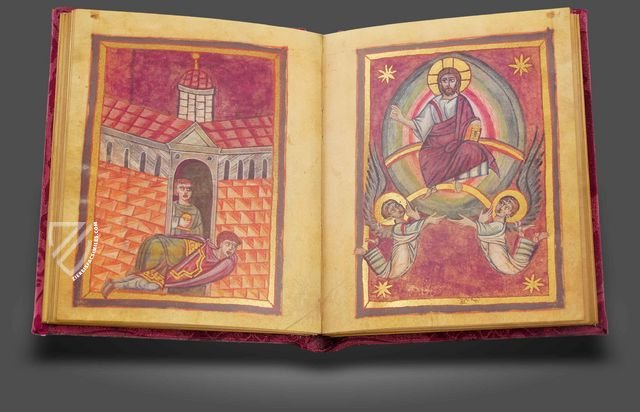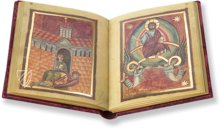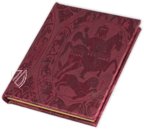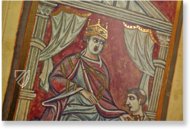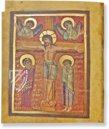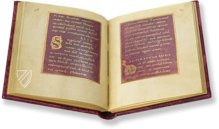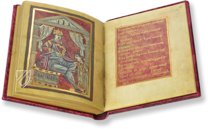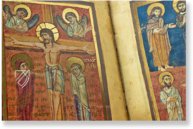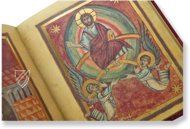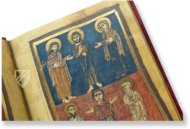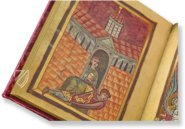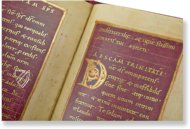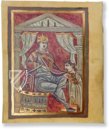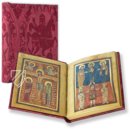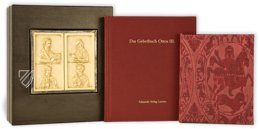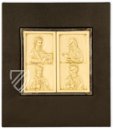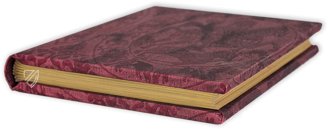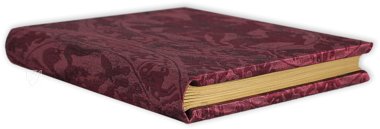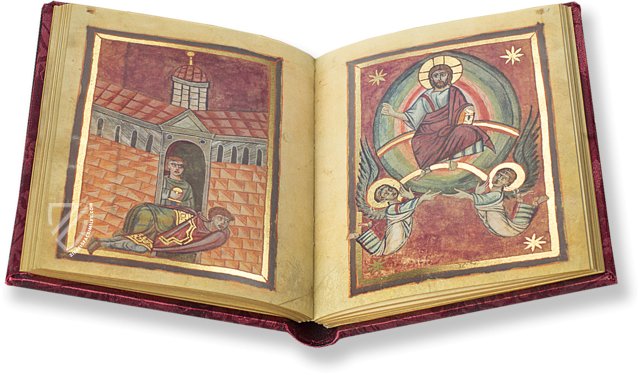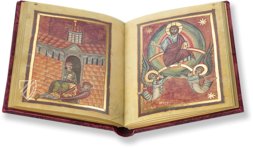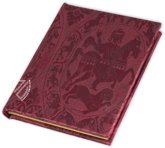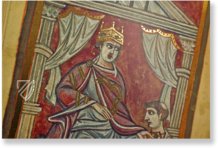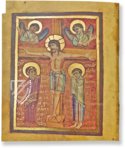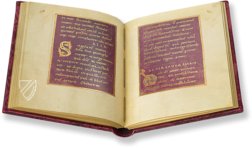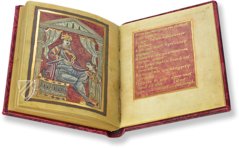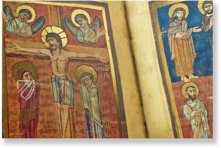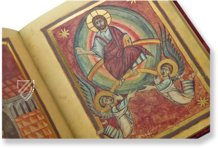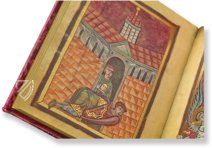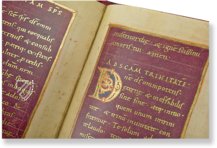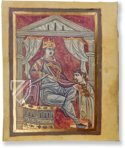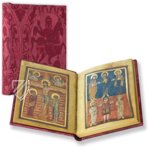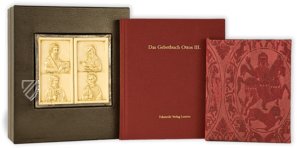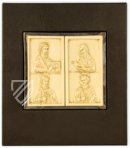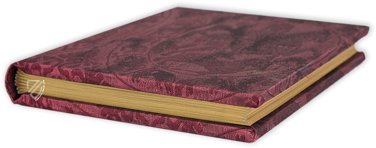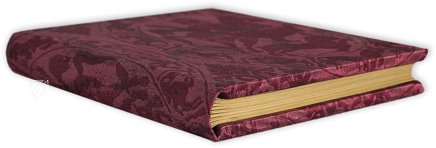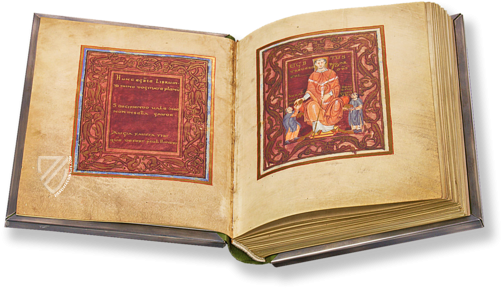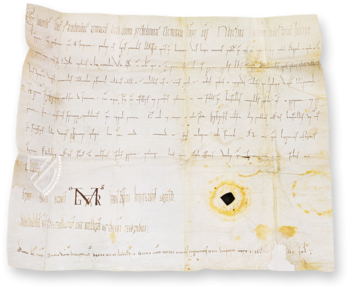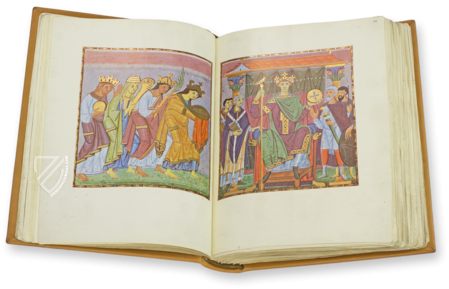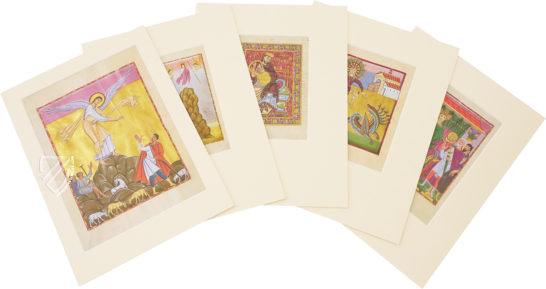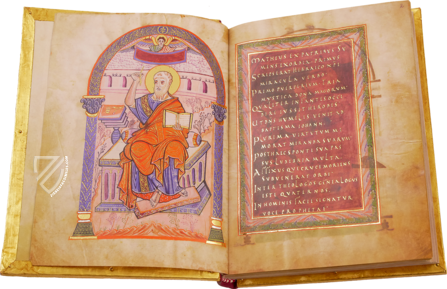Royal Prayer Book for Otto III
(1,000€ - 3,000€)
The Royal Prayer Book of Otto III has a unique place in history as the only surviving royal prayer book from the Ottonian era. Not only the miniatures, but also the script in gold on purple vellum indicate its extraordinary value. Even today, the private prayer book of the king and emperor bears witness to the artistry and splendor of early medieval book illumination. Created between 983 and 991, the codex, which is over a thousand years old, is a historically extremely valuable artefact and its artistic value as a historical monument is undisputed. Although it is the private prayer book of Otto III, the miniatures illustrate the ideal of the monastic ruler. In addition to deepening the faith, the book also served to convey the early medieval understanding of rulership, for the Ottonian emperors' ideal of rulership was closely linked to the Christian faith. In order to make the divine events depicted even more vivid, the king himself was depicted in the miniatures.
Royal Prayer Book for Otto III
The Royal Prayer Book of Otto III has a unique place in history as the only surviving royal prayer book from the Ottonian era. Its exceptional worth is indicated not only by the miniatures, but also the script in gold on purple vellum. One can still immerse themselves today in the splendor of the private prayer book of the king and emperor.
Ottonian Book Art
The Royal Prayer Book of Otto III originates from between 983 and 991 and still presents us today with the exceptional artistry and splendor of early medieval illumination. The manuscript has the unusual yet practical format for a private prayer book of 15 x 12 cm. The prayer book served the boy king and later emperors not only for immersion in the world of faith, but also to convey the foundations of early medieval understandings of sovereignty. Christian faith and the ideal ruler of the Ottonian Emperor were closely interconnected. The book was probably commissioned by Otto’s mother, the Byzantine Princess Theophano, or by her advisor, Archbishop Willigis von Mainz. It originates from between the crowing of the three-year-old Otto in 983 and the death of Theophano in 991.
A Kingly Work of Art
Each individual page of the prayer book bears witness to the worth of the manuscript. The prayers were applied to the most expensive painting surface: purple vellum. Additionally the pages were colored with the costly dye from the glands of the purple snail. Luminous gold ink was used against this dark background. To increase the splendor even more, 25 large gold initials are integrated into the text. There are also five pages of miniatures that buttress the worth of the manuscript. Although it was the private prayer book of Otto III, the monastic ideal ruler was also illustrated in the picture. The king himself is pictured in the miniatures. Three of the five miniatures show the portrait of the king. The scenes allow divine events to unfold before the eyes of the beholder during the prayer. In the pictures that Otto himself is a part of, he leads the event more emphatically still before our eyes. Thus the ruler is depicted on the side across from the crucifixion of Christ in the picture of the deesis surrounded by Christ and the saints. The second pair of pages of miniatures show Christ enthroned and flanked by angels in a mandorla on the recto page. The opposite page shows King Otto meekly laying on the ground. Finally, the dedication picture, in which King Otto receives the manuscript from a cleric, is especially impressively designed and is found next to the dedication poem of the author.
The Unique Historical Significance of the Manuscript
The significance of the manuscript is constituted not only through its artistic and art historic worth and the magnificence of the materials. The 1,000+ year-old codex is also a historical artifact of the highest worth. As the only surviving royal prayer book from the Ottonian era, the Royal Prayer Book of Otto III is a prominent historical monument and unique work of art. After the death of the emperor, the manuscript passed through many stations to Weissenstein palace in Pommersfelden and in 1994 finally came to Munich in the Bavarian State Library as a spectacular acquisition.
Codicology
- Alternative Titles
- Königsgebetbuch für Otto III.
- Size / Format
- 88 pages / 15.0 × 12.0 cm
- Origin
- Germany
- Date
- 983–991
- Epochs
- Style
- Genre
- Language
- Illustrations
- 5 full-page miniatures, 25 golden initials that extend over several lines and countless small initials at the beginning of each sentence, written completely in gold on a purple background
- Patron
- Empress Theophanu (960–991) or Saint Willigis (940–1011), Archbishop of Mainz
Royal Prayer Book for Otto III
Crucifixion
While earlier depictions of the Crucifixion showed all three crosses and various figures, artists began reducing the scene to its most basic elements in the 10th century. Thus, this scene shows just Christ Crucified flanked by the Virgin Mary, John the Evangelist, and two angels. Shimmering gold leaf halos attract attention to the surprisingly individualized and expressive faces of the figures, and also contrast wonderfully with the purple background that has faded to blood-red with time.
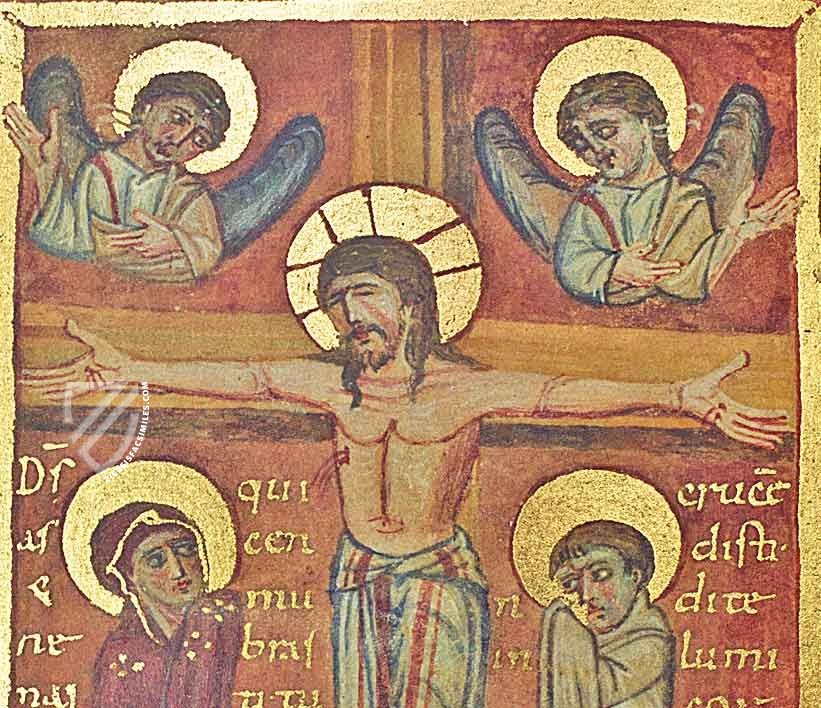
Royal Prayer Book for Otto III
Dedication Image: Otto III. Receives the Book from a Cleric
Unlike a patron portrait, a dedication image, also known as a presentation miniature, shows the recipient being presented with the manuscript, either by its patron or more often by the artist or scribe who completed it, as in this case. Despite the small size of this personal manuscript, a rarity in Ottonian art, the image maintains the solemn, monumental aesthetic of the style.
Purple, the imperial color, dominates the image and is wonderfully contrasted by the pale architecture, drapery, and simple robes of the monk. Otto is richly dressed in the style of a Roman Emperor and his crown, robes, throne, the codex, and the drapes are all accented with shimmering gold leaf. The fall of folds and facial expressions are particularly accomplished.
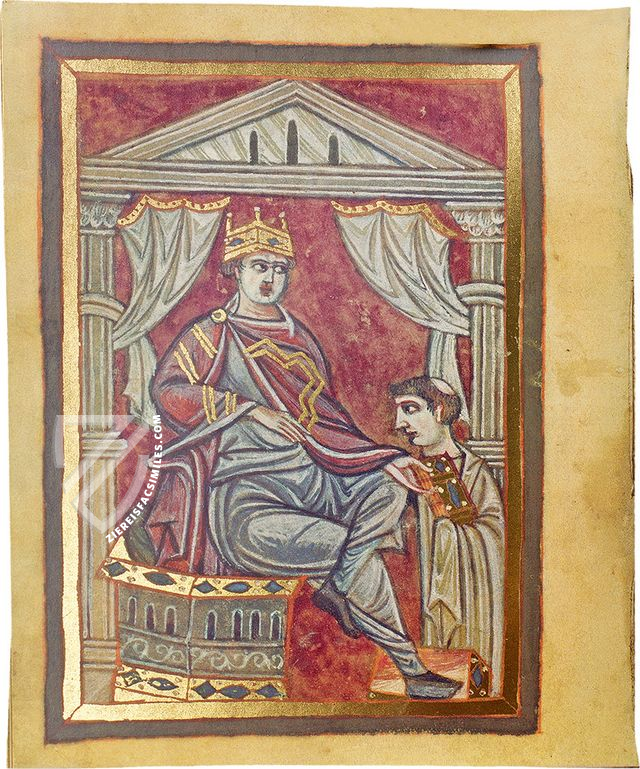
#1 Königsgebetbuch für Otto III.
Languages: English, German
(1,000€ - 3,000€)
- Treatises / Secular Books
- Apocalypses / Beatus
- Astronomy / Astrology
- Bestiaries
- Bibles / Gospels
- Chronicles / History / Law
- Geography / Maps
- Saints' Lives
- Islam / Oriental
- Judaism / Hebrew
- Single Leaf Collections
- Leonardo da Vinci
- Literature / Poetry
- Liturgical Manuscripts
- Medicine / Botany / Alchemy
- Music
- Mythology / Prophecies
- Psalters
- Other Religious Books
- Games / Hunting
- Private Devotion Books
- Other Genres
- Afghanistan
- Armenia
- Austria
- Belgium
- Belize
- Bosnia and Herzegovina
- China
- Colombia
- Costa Rica
- Croatia
- Cyprus
- Czech Republic
- Denmark
- Egypt
- El Salvador
- Ethiopia
- France
- Germany
- Greece
- Guatemala
- Honduras
- Hungary
- India
- Iran
- Iraq
- Israel
- Italy
- Japan
- Jordan
- Kazakhstan
- Kyrgyzstan
- Lebanon
- Liechtenstein
- Luxembourg
- Mexico
- Morocco
- Netherlands
- Palestine
- Panama
- Peru
- Poland
- Portugal
- Romania
- Russia
- Serbia
- Spain
- Sri Lanka
- Sweden
- Switzerland
- Syria
- Tajikistan
- Turkey
- Turkmenistan
- Ukraine
- United Kingdom
- United States
- Uzbekistan
- Vatican City
- A. Oosthoek, van Holkema & Warendorf
- Aboca Museum
- Ajuntament de Valencia
- Akademie Verlag
- Akademische Druck- u. Verlagsanstalt (ADEVA)
- Aldo Ausilio Editore - Bottega d’Erasmo
- Alecto Historical Editions
- Alkuin Verlag
- Almqvist & Wiksell
- Amilcare Pizzi
- Andreas & Andreas Verlagsbuchhandlung
- Archa 90
- Archiv Verlag
- Archivi Edizioni
- Arnold Verlag
- ARS
- Ars Magna
- ArtCodex
- AyN Ediciones
- Azimuth Editions
- Badenia Verlag
- Bärenreiter-Verlag
- Belser Verlag
- Belser Verlag / WK Wertkontor
- Benziger Verlag
- Bernardinum Wydawnictwo
- BiblioGemma
- Biblioteca Apostolica Vaticana (Vaticanstadt, Vaticanstadt)
- Bibliotheca Palatina Faksimile Verlag
- Bibliotheca Rara
- Boydell & Brewer
- Bramante Edizioni
- Bredius Genootschap
- Brepols Publishers
- British Library
- C. Weckesser
- Caixa Catalunya
- Canesi
- CAPSA, Ars Scriptoria
- Caratzas Brothers, Publishers
- Carus Verlag
- Casamassima Libri
- Centrum Cartographie Verlag GmbH
- Chavane Verlag
- Christian Brandstätter Verlag
- Circulo Cientifico
- Club Bibliófilo Versol
- Club du Livre
- CM Editores
- Collegium Graphicum
- Collezione Apocrifa Da Vinci
- Comissão Nacional para as Comemorações dos Descobrimentos Portugueses
- Coron Verlag
- Corvina
- CTHS
- D. S. Brewer
- Damon
- De Agostini/UTET
- De Nederlandsche Boekhandel
- De Schutter
- Deuschle & Stemmle
- Deutscher Verlag für Kunstwissenschaft
- DIAMM
- Droz
- E. Schreiber Graphische Kunstanstalten
- Ediciones Boreal
- Ediciones Grial
- Ediclube
- Edições Inapa
- Edilan
- Editalia
- Edition Deuschle
- Edition Georg Popp
- Edition Leipzig
- Edition Libri Illustri
- Editiones Reales Sitios S. L.
- Éditions de l'Oiseau Lyre
- Editions Medicina Rara
- Editorial Casariego
- Editorial Mintzoa
- Editrice Antenore
- Editrice Velar
- Edizioni Edison
- Egeria, S.L.
- Eikon Editores
- Electa
- Emery Walker Limited
- Enciclopèdia Catalana
- Eos-Verlag
- Ephesus Publishing
- Ernst Battenberg
- Eugrammia Press
- Extraordinary Editions
- Fackelverlag
- Facsimila Art & Edition
- Facsimile Editions Ltd.
- Facsimilia Art & Edition Ebert KG
- Faksimile Verlag
- Feuermann Verlag
- Folger Shakespeare Library
- Franco Cosimo Panini Editore
- Friedrich Wittig Verlag
- Fundación Hullera Vasco-Leonesa
- G. Braziller
- Gabriele Mazzotta Editore
- Gebr. Mann Verlag
- Gesellschaft für graphische Industrie
- Getty Research Institute
- Giovanni Domenico de Rossi
- Giunti Editore
- Graffiti
- Grafica European Center of Fine Arts
- Guido Pressler
- Guillermo Blazquez
- Gustav Kiepenheuer
- H. N. Abrams
- Harrassowitz
- Harvard University Press
- Helikon
- Hendrickson Publishers
- Henning Oppermann
- Herder Verlag
- Hes & De Graaf Publishers
- Hoepli
- Holbein-Verlag
- Houghton Library
- Hugo Schmidt Verlag
- Idion Verlag
- Il Bulino, edizioni d'arte
- ILte
- Imago
- Insel Verlag
- Insel-Verlag Anton Kippenberger
- Instituto de Estudios Altoaragoneses
- Instituto Nacional de Antropología e Historia
- Introligatornia Budnik Jerzy
- Istituto dell'Enciclopedia Italiana - Treccani
- Istituto Ellenico di Studi Bizantini e Postbizantini
- Istituto Geografico De Agostini
- Istituto Poligrafico e Zecca dello Stato
- Italarte Art Establishments
- Jan Thorbecke Verlag
- Johnson Reprint Corporation
- Josef Stocker
- Josef Stocker-Schmid
- Jugoslavija
- Karl W. Hiersemann
- Kasper Straube
- Kaydeda Ediciones
- Kindler Verlag / Coron Verlag
- Kodansha International Ltd.
- Konrad Kölbl Verlag
- Kurt Wolff Verlag
- La Liberia dello Stato
- La Linea Editrice
- La Meta Editore
- Lambert Schneider
- Landeskreditbank Baden-Württemberg
- Leo S. Olschki
- Les Incunables
- Liber Artis
- Library of Congress
- Libreria Musicale Italiana
- Lichtdruck
- Lito Immagine Editore
- Lumen Artis
- Lund Humphries
- M. Moleiro Editor
- Maison des Sciences de l'homme et de la société de Poitiers
- Manuscriptum
- Martinus Nijhoff
- Maruzen-Yushodo Co. Ltd.
- MASA
- Massada Publishers
- McGraw-Hill
- Metropolitan Museum of Art
- Militos
- Millennium Liber
- Müller & Schindler
- Nahar - Stavit
- Nahar and Steimatzky
- National Library of Wales
- Neri Pozza
- Nova Charta
- Oceanum Verlag
- Odeon
- Orbis Mediaevalis
- Orbis Pictus
- Österreichische Staatsdruckerei
- Oxford University Press
- Pageant Books
- Parzellers Buchverlag
- Patrimonio Ediciones
- Pattloch Verlag
- PIAF
- Pieper Verlag
- Plon-Nourrit et cie
- Poligrafiche Bolis
- Presses Universitaires de Strasbourg
- Prestel Verlag
- Princeton University Press
- Prisma Verlag
- Priuli & Verlucca, editori
- Pro Sport Verlag
- Propyläen Verlag
- Pytheas Books
- Quaternio Verlag Luzern
- Reales Sitios
- Recht-Verlag
- Reichert Verlag
- Reichsdruckerei
- Reprint Verlag
- Riehn & Reusch
- Roberto Vattori Editore
- Rosenkilde and Bagger
- Roxburghe Club
- Salerno Editrice
- Saltellus Press
- Sandoz
- Sarajevo Svjetlost
- Schöck ArtPrint Kft.
- Schulsinger Brothers
- Scolar Press
- Scrinium
- Scripta Maneant
- Scriptorium
- Shazar
- Siloé, arte y bibliofilia
- SISMEL - Edizioni del Galluzzo
- Sociedad Mexicana de Antropología
- Société des Bibliophiles & Iconophiles de Belgique
- Soncin Publishing
- Sorli Ediciones
- Stainer and Bell
- Studer
- Styria Verlag
- Sumptibus Pragopress
- Szegedi Tudomànyegyetem
- Taberna Libraria
- Tarshish Books
- Taschen
- Tempus Libri
- Testimonio Compañía Editorial
- Thames and Hudson
- The Clear Vue Publishing Partnership Limited
- The Facsimile Codex
- The Folio Society
- The Marquess of Normanby
- The Richard III and Yorkist History Trust
- Tip.Le.Co
- TouchArt
- TREC Publishing House
- TRI Publishing Co.
- Trident Editore
- Tuliba Collection
- Typis Regiae Officinae Polygraphicae
- Union Verlag Berlin
- Universidad de Granada
- University of California Press
- University of Chicago Press
- Urs Graf
- Vallecchi
- Van Wijnen
- VCH, Acta Humaniora
- VDI Verlag
- VEB Deutscher Verlag für Musik
- Verlag Anton Pustet / Andreas Verlag
- Verlag Bibliophile Drucke Josef Stocker
- Verlag der Münchner Drucke
- Verlag für Regionalgeschichte
- Verlag Styria
- Vicent Garcia Editores
- W. Turnowski Ltd.
- W. Turnowsky
- Waanders Printers
- Wiener Mechitharisten-Congregation (Wien, Österreich)
- Wissenschaftliche Buchgesellschaft
- Wissenschaftliche Verlagsgesellschaft
- Wydawnictwo Dolnoslaskie
- Xuntanza Editorial
- Zakład Narodowy
- Zollikofer AG

